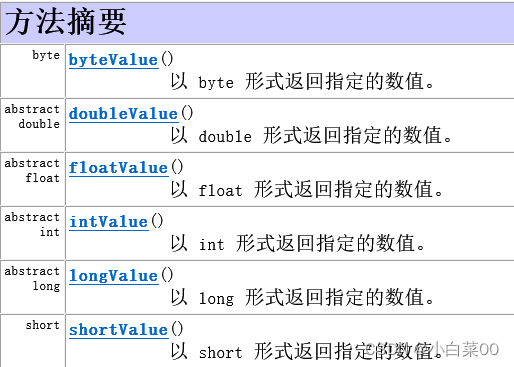目录
包装类
含义:将基本数据类型进行了封装,产生一个新的类,该类提供很多方法与功能,这就是包装类
引入包装类的原因:java是面向对象的语言,最擅长操作各种各样的类,通过包装类可以操作各种各样的属性、方法、构造器以实现更高级的功能
基本类型与包装类型对应关系
| 基本数据类型 | 对应的包装类 | 继承关系 |
| byte | Byte | —>Number—>Object |
| short | Short | —>Number—>Object |
| int | Integer | —>Number—>Object |
| long | Long | —>Number—>Object |
| float | Float | —>Number—>Object |
| double | Double | —>Number—>Object |
| char | Character | Object |
| boolean | Boolean | Object |
注意:
- 包装类为引用数据类型,其对基本数据类型进行了封装
- 包装类所属的包为java.lang,意味着我们使用的时候无需导包
Number
概述
注意:number为包装类的抽象父类,不可直接创建对象

方法(子类创建对象时使用)

Integer
注意:Integer类被final修饰意味着该类不能有子类,不能被继承
属性
- MAX_VALUE:值为2^31-1,他表示int类型能够表示的最大值
- MIN_VALUE:值为-2^31,他表示int类型能够表示的最小值
System.out.println(Integer.MAX_VALUE);//2147483647
System.out.println(Integer.MIN_VALUE);//-2147483648
//物极必反,最大值+1变成最小值,最小值-1变成最大值
System.out.println(Integer.MAX_VALUE+1);//-2147483647
System.out.println(Integer.MIN_VALUE-1);//2147483648构造器
注意:
- Integer没有空参构造器
- Integer重写了toString()方法,直接返回了对应的value值

//int类型作为构造器的参数
Integer integer = new Integer(12);
System.out.println(integer.toString());//12
//String类型作为构造器的参数
Integer integer1 = new Integer("12");//将string字符串转为int类型的数
System.out.println(integer1);//12包装类的特性
特性:自动装箱;自动拆箱
自动装箱与自动拆箱原理:将基本数据类型和包装类型进行了快速的类型转换
自动装箱
//自动装箱
Integer i=12;
System.out.println(i);//12
//自动装箱底层原理
Integer i2=Integer.valueOf(13);
System.out.println(i2);自动拆箱
//自动拆箱
Integer integer = new Integer(23);
int num=integer;
System.out.println(num);//23
//自动拆箱底层原理
Integer integer1=new Integer(33);
int num1=integer1.intValue();
System.out.println(num1);方法
compareTo()
语法:compareTo(Integer i)
作用:在数值上比较两个Integer的数,如果数值大于i那么返回1,如果数值小于i则返回-1,等于i则返回0
返回值:int
Integer integer = new Integer(23);
Integer integer1 = new Integer(25);
int i = integer.compareTo(integer1);
System.out.println(i);//-1equal()
语法:equal(Object obj)
作用:比较两个值是否相等
返回值:boolean
Integer integer = new Integer(23);
Integer integer1 = new Integer(23);
System.out.println(integer.equals(integer1));//true——比较数值是否相等
System.out.println(integer==integer1);//false——比较地址值是否相等自动装箱下的==比较
Integer i1=12;
Integer i2=12;
System.out.println(i1.equals(i2));//true
System.out.println(i1==i2);//true
Integer n1=130;
Integer n2=130;
System.out.println(n1.equals(n2));//true
System.out.println(n1==n2);//false注意:如果自动装箱的值在128——127之间那么比较的是具体数值的大小,否则比较的是地址值的大小(底层缓存数组);在Double类中没有此现象
intvalue()
语法:intValue()
作用:以int类型返回Integer的值
返回值:int
Integer i1=13;
int i = i1.intValue();
System.out.println(i);//13parseInt()
语法:Integer.parseInt(String s)
作用:将字符串参数作为有符号的十进制整数进行解析
返回值:int
String s="128";
int i = Integer.parseInt(s);
System.out.println(i);BigDecimal
作用:用于解决浮点数运算不精确问题
推荐创建对象方式
语法:BigDecimal(String s)
作用:将String类型字符串的形式转换为BigDecimal
返回值:BigDecimal类型的小数
方法
做加法运算:add(BigDecimal bd)
做减法运算:subtract(BigDecimal bd)
做乘法运算:multiply(BigDecimal bd)
BigDecimal bd1 = new BigDecimal("1.2");
BigDecimal bd2 = new BigDecimal("2.4");
//加法
BigDecimal add = bd1.add(bd2);
//减法
BigDecimal sub = bd1.subtract(bd2);
//乘法
BigDecimal mul = bd1.multiply(bd2);
System.out.println("相加得:"+add+"\n相减得:"+sub+"\n相乘得:"+mul);除法运算:
- Divide(BigDecimal bd)
- Divide(BigDecimal bd,保留小数位数,舍入方式)
注意:Divide(BigDecimal bd)做除法运算,除不尽时会抛异常
BigDecimal bd1 = new BigDecimal("6.38");
BigDecimal bd2 = new BigDecimal("2.1");
BigDecimal divide = bd1.divide(bd2,4, BigDecimal.ROUND_HALF_UP);
System.out.println(divide);关于除法舍入方式
使用方式:BigDecimal.参数
参数
- ROUND_HALF_UP 四舍五入
- ROUND_HALF_DOWN 五舍六入
- ROUND_HALF_EVEN 公平舍入(在5和6之间,靠近5就舍弃成5,靠近6就进位成6,如果是5.5,就变成6)
- ROUND_UP 直接进位
- ROUND_DOWN 直接舍弃
- ROUND_CEILING(天花板) 向上取整
- ROUND_FLOOR(地板) 向下取整
Math类
前言:
- 所在包为java.lang意味着我们可以直接使用而不用导包
- Math类被final修饰,该类不能被继承
- Math构造器私有化,不能创建Math类的对象
- Math内部所有的属性和方法都被static修饰,可以通过类名.属性直接调用
常用属性
语法:Math.PI
作用:该值为圆周率的值
常用方法
生成[0.0,1.0)之间的随机数:Math.Random()——底层调用的是Random类
取绝对值:Math.abs(整形或浮点类型的数)
向上取整:Math.ceil(浮点数)
向下取整:Math.floor(浮点数)
四舍五入:Math.round(浮点数)
求最大值:Math.max(值1,值2)
求最小值:Math.min(值1,值2)
System.out.println("圆周率为"+Math.PI);
System.out.println("0-1的随机数为"+Math.random());
System.out.println("绝对值"+Math.abs(-66));
System.out.println("向上取整"+Math.ceil(8.2));
System.out.println("向下取整"+Math.floor(8.9));
System.out.println("四舍五入"+Math.round(8.9));
System.out.println("最大值"+Math.max(4, 4.6));
System.out.println("最小值"+Math.min(4, 4.6));Random类
构造器

空参构造器创建对象
//利用空参构造器创建对象
Random random = new Random();
//获取[0,10)之间的随机整数数
int i = random.nextInt(10);
System.out.println(i);
//获取[0.0,1.0)之间的随机小数
double v = random.nextDouble();
System.out.println(v);注意:无参构造器表面在调用无参构造函数 ,实际底层还是调用了带参构造方法
带参构造器创建对象
//内部传一个不断变化的long类型数,得到随机数生成器
Random random = new Random(System.currentTimeMillis());
//利用随机生成器获取int类型随机数
int i = random.nextInt();
System.out.println(i);
//获取[0,10)之间的随机整数
int i1 = random.nextInt(10);
System.out.println(i1);
//获取[0.0,1.0)之间的随机小数
double v = random.nextDouble();
System.out.println(v);





















 270
270











 被折叠的 条评论
为什么被折叠?
被折叠的 条评论
为什么被折叠?








